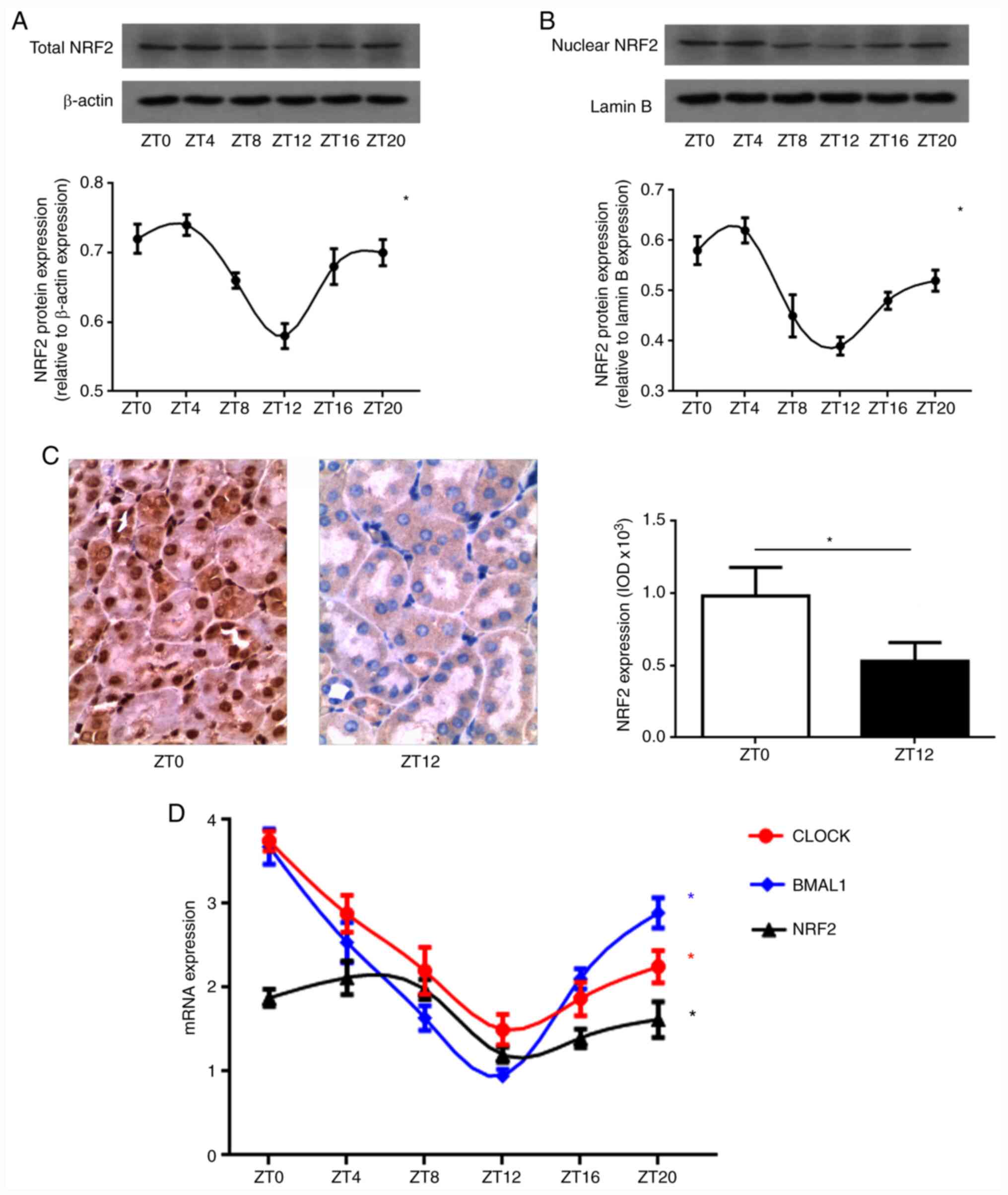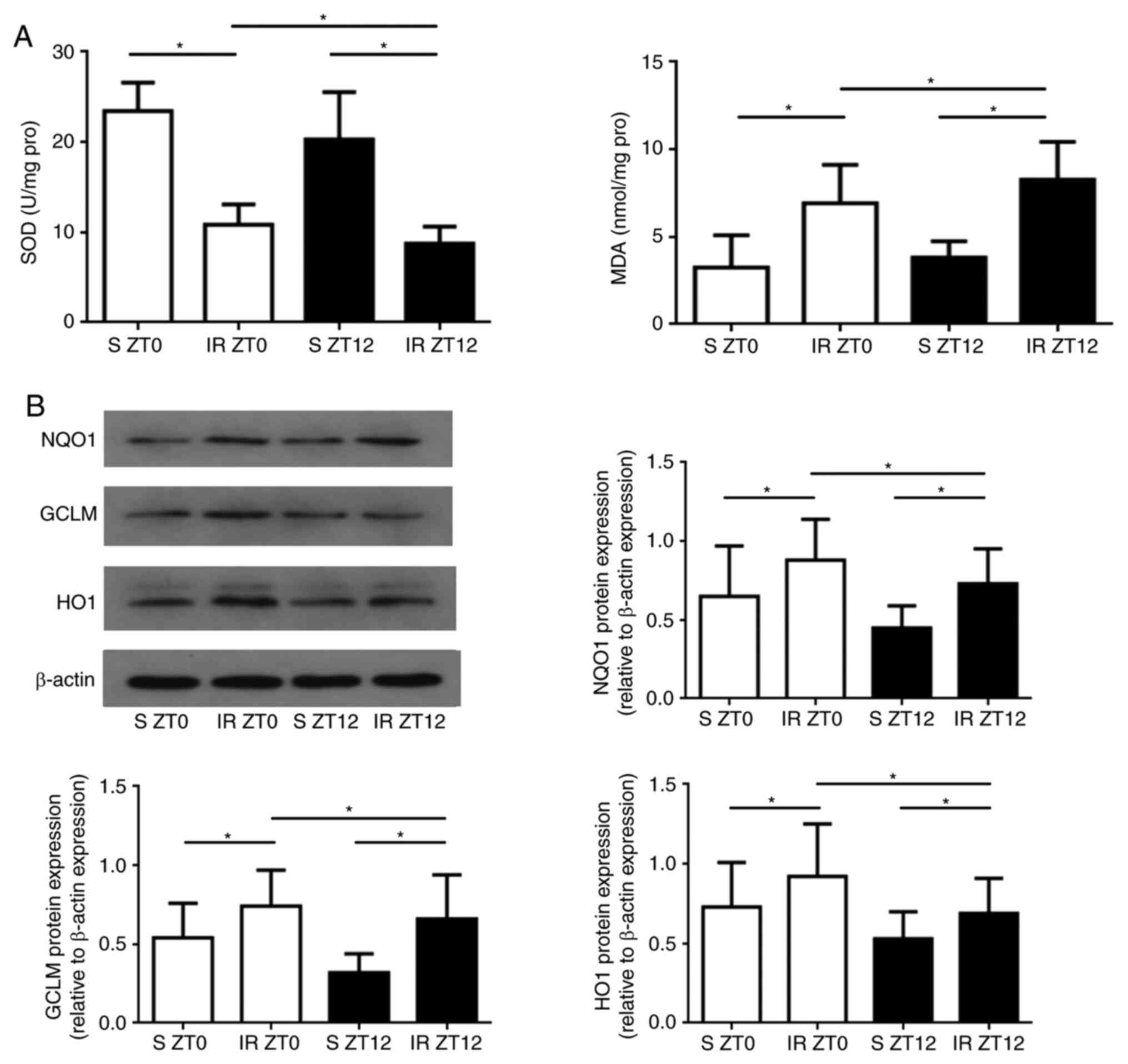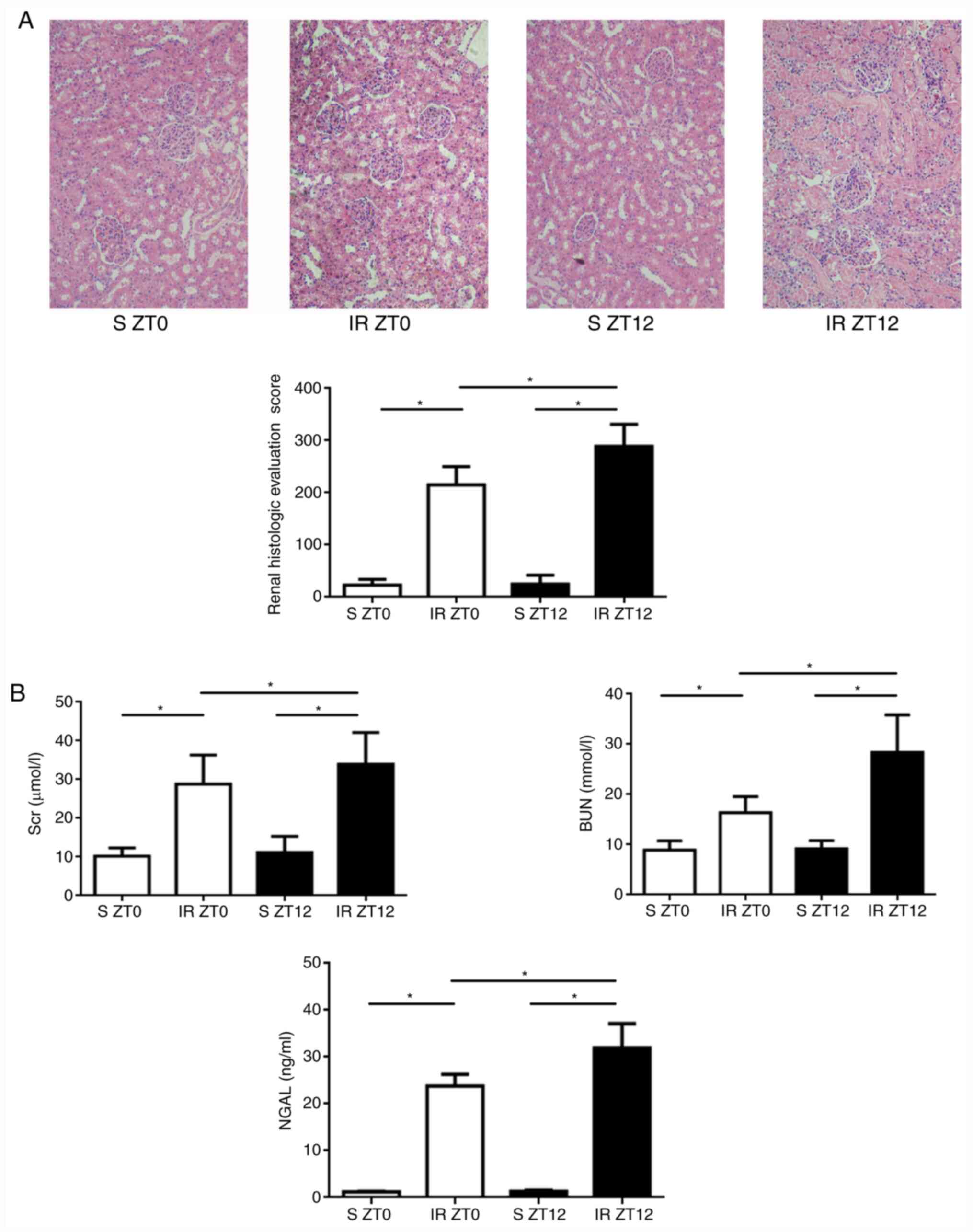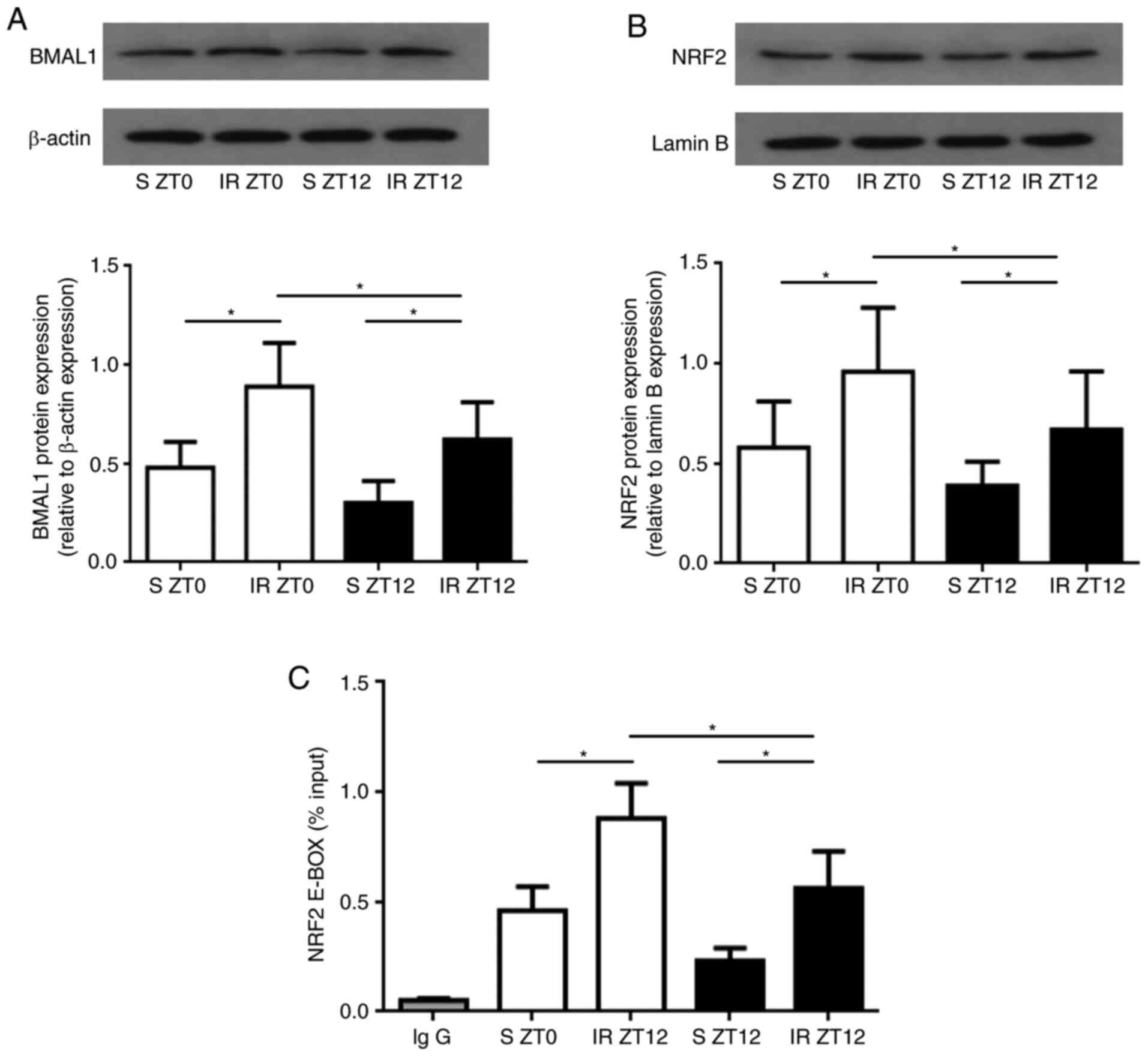|
1
|
Bollinger T and Schibler U: Circadian
rhythms-from genes to physiology and disease. Swiss Med Wkly.
144(w13984)2014.PubMed/NCBI View Article : Google Scholar
|
|
2
|
Wilking M, Ndiaye M, Mukhtar H and Ahmad
N: Circadian rhythm connections to oxidative stress: Implications
for human health. Antioxid Redox Signal. 19:192–208.
2013.PubMed/NCBI View Article : Google Scholar
|
|
3
|
Pei JF, Li XK, Li WQ, Gao Q, Zhang Y, Wang
XM, Fu JQ, Cui SS, Qu JH, Zhao X, et al: Diurnal oscillations of
endogenous H2O2 sustained by
p66Shc regulate circadian clocks. Nat Cell Biol.
21:1553–1564. 2019.PubMed/NCBI View Article : Google Scholar
|
|
4
|
Tonelli C, Chio IIC and Tuveson DA:
Transcriptional regulation by Nrf2. Antioxid Redox Signal.
29:1727–1745. 2018.PubMed/NCBI View Article : Google Scholar
|
|
5
|
Tamaru T, Hattori M, Ninomiya Y, Kawamura
G, Varès G, Honda K, Mishra DP, Wang B, Benjamin I, Sassone-Corsi
P, et al: ROS stress resets circadian clocks to coordinate
pro-survival signals. PLoS One. 8(e82006)2013.PubMed/NCBI View Article : Google Scholar
|
|
6
|
Desvergne A, Ugarte N, Radjei S, Gareil M,
Petropoulos I and Friguet B: Circadian modulation of proteasome
activity and accumulation of oxidized protein in human embryonic
kidney HEK 293 cells and primary dermal fibroblasts. Free Radic
Biol Med. 94:195–207. 2016.PubMed/NCBI View Article : Google Scholar
|
|
7
|
Wible RS, Ramanathan C, Sutter CH, Olesen
KM, Kensler TW, Liu AC and Sutter TR: NRF2 regulates core and
stabilizing circadian clock loops, coupling redox and timekeeping
in Mus musculus. Elife. 7(e31656)2018.PubMed/NCBI View Article : Google Scholar
|
|
8
|
Sun Q, Shen ZY, Duan WN, Meng QT and Xia
ZY: Mechanism of myocardial ischemia/reperfusion-induced acute
kidney injury through DJ-1/Nrf2 pathway in diabetic rats. Exp Ther
Med. 14:4201–4207. 2017.PubMed/NCBI View Article : Google Scholar
|
|
9
|
Pekovic-Vaughan V, Gibbs J, Yoshitane H,
Yang N, Pathiranage D, Guo B, Sagami A, Taguchi K, Bechtold D,
Loudon A, et al: The circadian clock regulates rhythmic activation
of the NRF2/glutathione-mediated antioxidant defense pathway to
modulate pulmonary fibrosis. Genes Dev. 28:548–560. 2014.PubMed/NCBI View Article : Google Scholar
|
|
10
|
Firsov D and Bonny O: Circadian rhythms
and the kidney. Nat Rev Nephrol. 14:626–635. 2018.PubMed/NCBI View Article : Google Scholar
|
|
11
|
Spandou E, Tsouchnikas I, Karkavelas G,
Dounousi E, Simeonidou C, Guiba-Tziampiri O and Tsakiris D:
Erythropoietin attenuates renal injury in experimental acute renal
failure ischaemic/reperfusion model. Nephrol Dial Transplant.
21:330–336. 2006.PubMed/NCBI View Article : Google Scholar
|
|
12
|
Chen R, Zeng Z, Zhang YY, Cao C, Liu HM,
Li W, Wu Y, Xia ZY, Ma D and Meng QT: Ischemic postconditioning
attenuates acute kidney injury following intestinal
ischemia-reperfusion through Nrf2-regulated autophagy,
anti-oxidation, and anti-inflammation in mice. FASEB J.
34:8887–8901. 2020.PubMed/NCBI View Article : Google Scholar
|
|
13
|
Sun Q, Meng QT, Jiang Y, Liu HM, Lei SQ,
Su WT, Duan WN, Wu Y and Xia ZY and Xia ZY: Protective effect of
ginsenoside Rb1 against intestinal ischemia-reperfusion induced
acute renal injury in mice. PLoS One. 8(e80859)2013.PubMed/NCBI View Article : Google Scholar
|
|
14
|
Livak KJ and Schmittgen TD: Analysis of
relative gene expression data using real-time quantitative PCR and
the 2(-Delta Delta C(T)) method. Methods. 25:402–408.
2001.PubMed/NCBI View Article : Google Scholar
|
|
15
|
Solocinski K and Gumz ML: The circadian
clock in the regulation of renal rhythms. J Biol Rhythms.
30:470–486. 2015.PubMed/NCBI View Article : Google Scholar
|
|
16
|
Johnston JG and Pollock DM: Circadian
regulation of renal function. Free Radic Biol Med. 119:93–107.
2018.PubMed/NCBI View Article : Google Scholar
|
|
17
|
Montaigne D, Marechal X, Modine T, Coisne
A, Mouton S, Fayad G, Ninni S, Klein C, Ortmans S, Seunes C, et al:
Daytime variation of perioperative myocardial injury in cardiac
surgery and its prevention by Rev-Erbα antagonism: A single-centre
propensity-matched cohort study and a randomized study. Lencet.
391:59–69. 2018.PubMed/NCBI View Article : Google Scholar
|
|
18
|
Durgan DJ, Pulinilkunnil T,
Villegas-Montoya C, Garvey ME, Frangogiannis NG, Michael LH, Chow
CW, Dyck JR and Young ME: Short communication: Ischemia/reperfusion
tolerance is time-of-day-dependent: Mediation by the cardiomyocyte
circadian clock. Circ Res. 106:546–550. 2010.PubMed/NCBI View Article : Google Scholar
|
|
19
|
Rotter D, Grinsfelder DB, Parra V, Pedrozo
Z, Singh S, Sachan N and Rothermel BA: Calcineurin and its
regulator, RCAN1, confer time-of-day changes in susceptibility of
the heart to ischemia/reperfusion. J Mol Cell Cardiol. 74:103–111.
2014.PubMed/NCBI View Article : Google Scholar
|
|
20
|
Beker MC, Caglayan B, Yalcin E, Caglayan
AB, Turkseven S, Gurel B, Kelestemur T, Sertel E, Sahin Z, Kutlu S,
et al: Time-of-day dependent neuronal injury after ischemic stroke:
Implication of circadian clock transcriptional factor Bmal1 and
survival kinase AKT. Mol Neurobiol. 55:2565–2576. 2018.PubMed/NCBI View Article : Google Scholar
|
|
21
|
Russcher M, Nagtegaal JE, Nurmohamed SA,
Koch BC, van der Westerlaken MM, van Someren EJ, Bakker SJ, Ter Wee
PM and Gaillard CA: The effects of kidney transplantation on sleep,
melatonin, circadian rhythm and quality of life in kidney
transplant recipients and living donors. Nephron. 129:6–15.
2015.PubMed/NCBI View Article : Google Scholar
|
|
22
|
Sun Q, Meng QT, Jiang Y and Xia ZY:
Ginsenoside Rb1 attenuates intestinal ischemia reperfusion induced
renal injury by activating Nrf2/ARE pathway. Molecules.
17:7195–7205. 2012.PubMed/NCBI View Article : Google Scholar
|
|
23
|
Yang G, Wright CJ, Hinson MD, Fernando AP,
Sengupta S, Biswas C, La P and Dennery PA: Oxidative stress and
inflammation modulate Rev-erbα signaling in the neonatal lung and
affect circadian rhythmicity. Antioxid Redox Signal. 21:17–32.
2014.PubMed/NCBI View Article : Google Scholar
|
|
24
|
Wende AR, Young ME, Chatham J, Zhang J,
Rajasekaran NS and Darley-Usmar VM: Redox biology and the interface
between bioenergetics, autophagy and circadian control of
metabolism. Free Radic Biol Med. 100:94–107. 2016.PubMed/NCBI View Article : Google Scholar
|
|
25
|
Cheng Z, Qian S, Qingtao M, Zhongyuan X
and Yeda X: Effects of ATRA on diabetic rats with renal
ischemia-reperfusion injury. Acta Cir Bras.
35(e202000106)2020.PubMed/NCBI View Article : Google Scholar
|


















